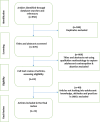Contraception and abortion knowledge, attitudes and practices among adolescents from low and middle-income countries: a systematic review
- PMID: 30497464
- PMCID: PMC6267062
- DOI: 10.1186/s12913-018-3722-5
Contraception and abortion knowledge, attitudes and practices among adolescents from low and middle-income countries: a systematic review
Erratum in
-
Correction to: Contraception and abortion knowledge, attitudes and practices among adolescents from low and middle-income countries: a systematic review.BMC Health Serv Res. 2019 Jul 2;19(1):441. doi: 10.1186/s12913-019-4297-5. BMC Health Serv Res. 2019. PMID: 31266484 Free PMC article.
Abstract
Background: Adolescents face significant barriers to contraception access and utilization that result in adverse health effects of early pregnancy and childbirth. Unsafe abortions continue to occur partly due to failure to prevent pregnancies, with Sub-Saharan Africa contributing the most significant burden of all unsafe abortions among young people globally, of which a quarter occurs in those aged 15-19 years. We aimed to conduct a systematic review of the contraceptive and abortion knowledge, attitudes and practices of adolescents in low and middle-income countries to increase the understanding of the sexual and reproductive health dynamics that they face.
Methods: Literature searches from 6 databases; PubMed, Science Direct, Google Scholar, BioMed Central, CINAHL, MEDLINE, were conducted, covering the period from 1970 to 2016 and concerning the adolescents aged 15-19 years and 21 studies were read and analyzed using thematic analysis.
Results: Limited knowledge about sexual and reproductive health among adolescents was a significant cause of reduced access to contraception and safe abortion services, especially among unmarried adolescents. Reduced access to reproductive health services for some resulted in extreme methods of contraception and abortion such as the use of battery acid and crushed bottles. Despite all adolescents having limited access to information and services, girls faced more consequences such as being blamed for pregnancy or dealing with the effects of unsafe abortions. Parents, health workers, and teachers were cited as trusted sources of information but often received the most information from peers and other family members instead, and the girls mostly confided in their aunties, cousins and peers while the boys resorted to peers, media and even pornography.
Conclusion: The reported observations suggest severe limitations in the access to safe and effective methods of contraception and safe abortion services. There is a need for an urgent response in reducing the "unmet needs" for contraception and to improve access to contraception, abortion information, and services in this group. Interventions which target the involvement of parents and teachers should be considered, to carry one wholesome message to the adolescents.
Keywords: Abortion; Adolescents; Contraception; Systematic review.
Conflict of interest statement
Ethics approval and consent to participate
Not applicable.
Consent for publication
Not applicable.
Competing interests
The authors declare that they have no competing interests.
Publisher’s Note
Springer Nature remains neutral with regard to jurisdictional claims in published maps and institutional affiliations.
Similar articles
-
Behavioral barriers to the use of modern methods of contraception among unmarried youth and adolescents in eastern Senegal: a qualitative study.BMC Public Health. 2020 Jun 29;20(1):1025. doi: 10.1186/s12889-020-09131-4. BMC Public Health. 2020. PMID: 32600290 Free PMC article.
-
Would you offer contraception to a 14-year-old girl? Perspectives of health students and professionals in Dar es Salaam, Tanzania.Reprod Health. 2021 Dec 11;18(1):245. doi: 10.1186/s12978-021-01294-6. Reprod Health. 2021. PMID: 34895267 Free PMC article.
-
The potential impact of improvements in contraception on fertility and abortion in Western countries.Eur J Popul. 1987 Nov;3(1):7-32. doi: 10.1007/BF01797090. Eur J Popul. 1987. PMID: 12280731
-
Contraception for adolescents in low and middle income countries: needs, barriers, and access.Reprod Health. 2014 Jan 2;11(1):1. doi: 10.1186/1742-4755-11-1. Reprod Health. 2014. PMID: 24383405 Free PMC article. Review.
-
Abortion and fertility regulation.Lancet. 1996 Jun 15;347(9016):1663-8. doi: 10.1016/s0140-6736(96)91491-9. Lancet. 1996. PMID: 8642962 Review.
Cited by
-
Pooled prevalence and associated factors of teenage pregnancy among women aged 15 to 19 years in sub-Saharan Africa: evidence from 2019 to 2022 demographic and health survey data.Contracept Reprod Med. 2024 May 23;9(1):26. doi: 10.1186/s40834-024-00289-5. Contracept Reprod Med. 2024. PMID: 38778418 Free PMC article.
-
Knowledge and uptake of contraceptive and other sexual reproductive health services among in-school adolescents in three South African townships: Baseline findings from the Girls Achieve Power (GAP Year) Trial.Gates Open Res. 2024 Nov 11;6:67. doi: 10.12688/gatesopenres.13636.3. eCollection 2022. Gates Open Res. 2024. PMID: 37249956 Free PMC article.
-
Scoping review of qualitative studies on family planning in Uganda.PLOS Glob Public Health. 2024 Jul 3;4(7):e0003313. doi: 10.1371/journal.pgph.0003313. eCollection 2024. PLOS Glob Public Health. 2024. PMID: 38959214 Free PMC article.
-
Does education sculpt healthcare choices? Exploring factors influencing healthcare utilization among female youths in eight low and lower-middle-income countries.PLoS One. 2025 Mar 17;20(3):e0298782. doi: 10.1371/journal.pone.0298782. eCollection 2025. PLoS One. 2025. PMID: 40096074 Free PMC article.
-
[Adolescents and teachers´ knowledge, attitude and practice towards contraception: results from a qualitative study conducted in the Democratic Republic of the Congo].Pan Afr Med J. 2021 Feb 3;38:121. doi: 10.11604/pamj.2021.38.121.21678. eCollection 2021. Pan Afr Med J. 2021. PMID: 33912291 Free PMC article. French.
References
-
- Grimes D, et al. Unsafe abortion: the preventable pandemic. Lancet Sex Reprod Health Ser. 2006;368. - PubMed
-
- Darroch JE, et al. Costs and benefits of meeting the contraceptive needs of adolescents. 2016.
-
- Guttmacher, I. Reasons for Unmet Need For Contraception in Developing Countries. 2016 [cited 2017 19/01/2017]; Available from: https://www.guttmacher.org/fact-sheet/unmet-need-for-contraception-in-de....
Publication types
MeSH terms
Substances
LinkOut - more resources
Full Text Sources
Medical


